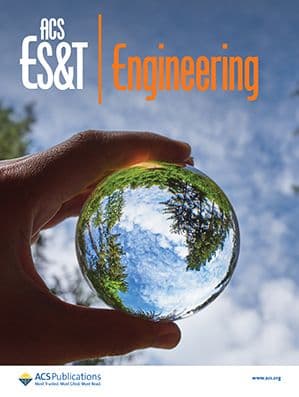In this interview, Editor-in-Chief Wonyong Choi reflects on the journal's first five years, the trends shaping the field, and the exciting road that lies ahead.

Five years ago, ACS ES&T Engineering embarked on a bold mission: to redefine the landscape of environmental technology and engineering through rigorous science and visionary leadership. As the journal celebrates its 5th anniversary, it's a moment to reflect on the impact it has made—driving innovation, fostering global collaboration, and advancing solutions to some of the world’s most pressing environmental challenges.
To mark this milestone, we sat down with Professor Wonyong Choi, Editor-in-Chief of ACS ES&T Engineering, for an insightful conversation on the journal’s journey so far, the trends shaping the field, and the exciting road that lies ahead.

The Journey of ACS ES&T Engineering
What inspired the launch of the journal, and what gap did it aim to fill in the research landscape?
ACS ES&T Engineering (ES&TE) was launched in response to the growing demand for a dedicated publication platform in environmental technology and engineering. Environmental Science & Technology (ES&T), the most recognized journal in the field, had limited capacity to accommodate high-quality engineering-focused papers. This was particularly evident as the environmental research field rapidly expanded, becoming more interdisciplinary. Many excellent engineering manuscripts, particularly those with practical relevance but lacking purely novel science, struggled to find a home. We created ES&TE to address this imbalance and to serve as a premier platform for environmental engineers and applied researchers whose work solves real-world environmental challenges through innovation, systems thinking, and technology integration.
What were some of the biggest challenges in establishing the journal, and how were they overcome?
The launch of a new journal inevitably entails a bold commitment and vision for the future, especially when building credibility in a field dominated by long-established competitors. One of the biggest challenges was ensuring that ES&TE would not be perceived as a secondary outlet or a place for papers rejected from ES&T. We addressed this by maintaining very high editorial standards from the beginning. In fact, over 40% of submissions were desk-rejected without peer review to maintain quality. Another challenge was resisting the pressure to grow quickly through manuscript transfers. While ACS was supportive of integrating ES&TE into its transfer system early on, we made the deliberate decision to delay this until the journal had established a strong reputation on its own merit.
Are there any standout moments or personal highlights from the past five years?
There are many, but a few moments stand out. Receiving our first partial Journal Impact Factor™ (JIF) of 7.1 in 2023, and later the full 2-year JIF of 7.4 in 2024, was a significant milestone. Another highlight has been the tremendous global engagement: submissions from 70+ countries, with a strong presence from China, the U.S., and growing interest in India and Europe.
Scientific and Editorial Evolution
How has the field of environmental chemical engineering evolved over the past five years?
The field has seen remarkable transformation, becoming more data-driven, more interdisciplinary, and more urgent in its response to global challenges. We've seen the convergence of environmental catalysis, materials science, and data science, with rising interest in carbon capture and utilization (CCU), decentralized water treatment, and climate-resilient technologies. Importantly, environmental engineers are no longer working in disciplinary silos. They are collaborating with computational scientists, energy researchers, and synthetic biologists. This shift has fundamentally changed what we define as “environmental engineering.”
How has ACS ES&T Engineering adapted to changes in the research landscape?
ES&TE has embraced this interdisciplinary evolution by expanding its topical coverage and launching special issues on emerging themes like photo(electro)catalysis, electrified membranes, free radical chemistry, and computational modeling. We’ve also fostered faster turnaround times, currently averaging 19 days to the first decision. We've intentionally moved beyond the "traditional" environmental engineering themes and have welcomed papers from catalysis, materials design, biotechnology, and even climate tech. This inclusive approach has helped us remain relevant and forward-looking.
What role does the journal play in advancing interdisciplinary and emerging research areas?
Our role is twofold: first, to provide a high-impact platform for cross-disciplinary research that doesn't always fit the scope of legacy journals; and second, to catalyze innovation by bringing disparate communities together. We actively recruit authors, guest editors, and reviewers from adjacent fields, such as nanotechnology, electrochemistry, and AI for environmental applications, to ensure diverse perspectives and foster novel collaborations.
Looking Forward: The Next Five Years
What are the key research trends that will shape the future of environmental engineering?
Several trends are becoming increasingly prominent:
- Electrification and decarbonization of environmental processes,
- Resource recovery and circular economy approaches,
- Data- and AI-driven environmental modeling, and
- Climate technologies including water-energy nexus innovations.
I believe the integration of sustainability metrics, life-cycle analysis, and systems engineering principles will also become standard in high-impact research.
How can ACS ES&T Engineering continue to grow its impact and global reach?
We need to continue expanding geographically. While China and the U.S. dominate submissions, we are focusing on building stronger ties in Europe, India, Latin America, and Africa through editorial advisory board recruitment and author outreach. To grow impact, we will promote more review and perspective articles. Collaborations with other ACS journals and increased visibility through social media and virtual events will also help expand our reach.
What advice would you give to early-career researchers looking to contribute to the journal?
Focus on work that not only demonstrates technical excellence but also addresses real environmental challenges. ES&TE values innovation with practical relevance. Don’t hesitate to submit emerging ideas. We welcome perspectives that stimulate new thinking. We also encourage you to engage actively with the journal by serving as a reviewer and contributing as a frequent author. These efforts are highly valued and may open the door to opportunities such as joining the Early Career Board. Getting involved with a new journal in an early phase allows you to grow with the journal throughout your academic career.
Finally, ACS ES&T Engineering has published some noteworthy research in the past five years. Could you identify five of your personal favorites (one for each year) and share what made each of them stand out to you?
Effect of Process Variables on Food Waste Valorization via Hydrothermal Liquefaction
Bita Motavaf and Phillip E. Savage*
DOI: 10.1021/acsestengg.0c00115
This study stands out for its innovative approach to converting food waste into valuable biofuels using hydrothermal liquefaction, addressing both waste management and renewable energy production.
Electrified Membranes for Water Treatment Applications
Meng Sun, Xiaoxiong Wang, Lea R. Winter, Yumeng Zhao, Wen Ma, Tayler Hedtke, Jae-Hong Kim, and Menachem Elimelech*
DOI: 10.1021/acsestengg.1c00015
This highly cited review helped define a new frontier in environmental technology, the intersection of membrane science and electrochemical engineering. It became a seminal piece for researchers exploring advanced membrane systems for selective pollutant removal and energy efficiency. It reflects ES&TE’s mission to support innovative, application-oriented engineering solutions.
Emerging Trends and Prospects for Municipal Wastewater Management in China
Jiuhui Qu, Xiaohu Dai, Hong-Ying Hu, Xia Huang, Zhuo Chen, Tao Li, Yeshi Cao, and Glen T. Daigger*
DOI: 10.1021/acsestengg.1c00345
This hybrid critical review offered a deep and timely analysis of China's municipal wastewater strategies. It resonated globally due to its scalable insights into infrastructure, regulation, and environmental policy. Its systems-level thinking aligns perfectly with ES&TE’s vision for transformative environmental technologies.
Prediction and Evaluation of Indirect Carbon Emission from Electrical Consumption in Multiple Full-Scale Wastewater Treatment Plants via Automated Machine Learning-Based Analysis
Runze Xu, Yi Li, Yuting Luo, Fang Fang, Qian Feng, Jiashun Cao, and Jingyang Luo*
DOI: 10.1021/acsestengg.2c00306
This article stands out for its innovative use of AutoML to accurately assess carbon emissions from WWTPs. This approach enhances predictive performance and simplifies model selection, making it highly applicable in real-world environmental management. The study supports the development of sustainable wastewater treatment by identifying key emission drivers. Overall, it bridges machine learning with environmental engineering to advance carbon reduction efforts.
New Insight into the Antagonism Mechanism between Binary VOCs during Their Degradation over Pd/ZrO2 Catalysts
Fukun Bi, Jiafeng Wei, Bin Gao, Ning Liu, Jingcheng Xu, Baolin Liu, Yuandong Huang, and Xiaodong Zhang*
DOI: 10.1021/acsestengg.3c00630
It provides a novel understanding of how toluene and acetone interact antagonistically during catalytic degradation. This mechanistic insight is critical for designing more effective catalysts for treating mixed VOC emissions in real-world applications. The study addresses a practical challenge in environmental catalysis, often overlooked in single-compound studies, highlighting its relevance to improving air purification technologies.
Learn More About ACS ES&T Engineering
Stay Connected with e-Alerts
Never miss an issue again! Sign up now for the latest updates and content from ACS ES&T Engineering, including future issue alerts, new articles, calls for papers, and more.

Register for e-Alerts from ACS ES&T Engineering
Submit Your Research to ACS ES&T Engineering
Does your research focus on solving complex environmental challenges through engineering and systems-level solutions? Help drive interdisciplinary progress in environmental innovation by submitting your next paper to ACS ES&T Engineering.
